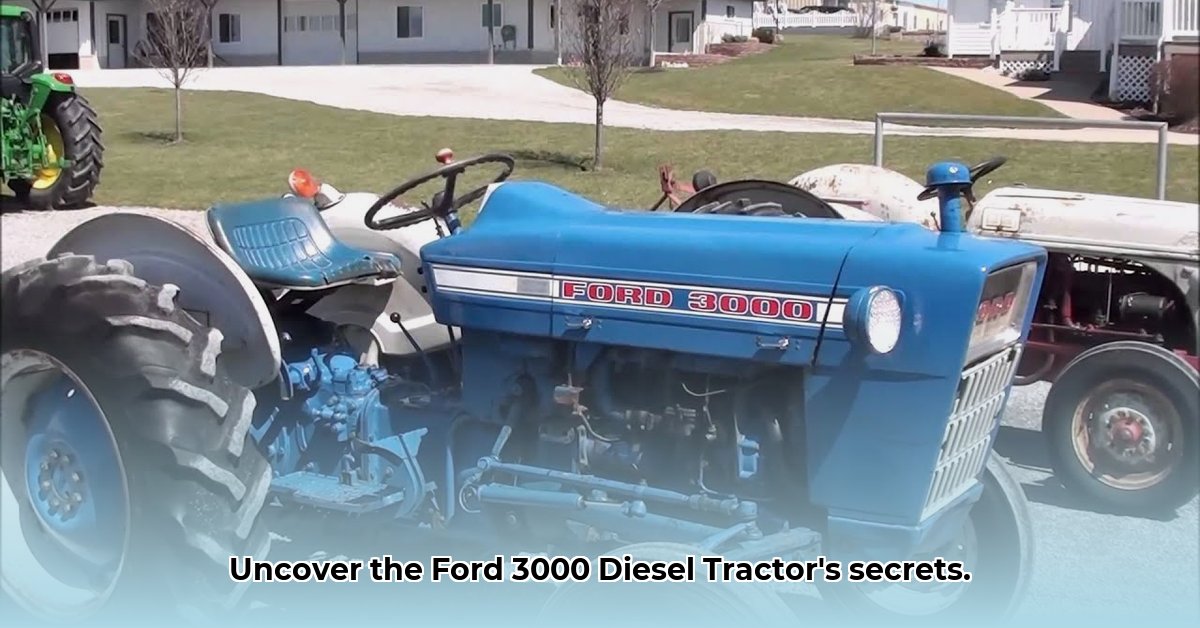
The Ford 3000 diesel tractor, a ubiquitous sight in fields across the globe during the 1960s and 70s, remains a compelling subject for both agricultural historians and classic machinery enthusiasts. Manufactured in Belgium, England, and the USA, its adaptability and sturdy build cemented its place in farming history. However, its legacy is not without its complexities, particularly regarding its often-conflicting horsepower specifications. This guide aims to navigate those intricacies, offering a comprehensive overview of this iconic workhorse. For more information on maintenance, check out this helpful resource on hydraulic filter replacement.
The Engine: A Tale of Horsepower and Variance
One of the most significant challenges in researching the Ford 3000 diesel is the inconsistent reporting of horsepower figures. Sources cite a wide range of numbers, a variation likely stemming from several factors: engine type (diesel or gasoline), transmission configuration, and PTO (Power Take-Off) speed. Did these differences reflect actual variations in engine output, or were they simply a result of inconsistent measurement techniques of the era? Further investigation is required for definitive answers. Typically, the tractors were equipped with either a 2.6-liter or a 2.9-liter three-cylinder diesel engine, although gasoline-powered variants existed. These variations almost certainly contributed to the discrepancies in horsepower ratings found across various sources. Isn't it fascinating how a single specification can be so elusive?
Transmission and PTO: Flexibility for the Farmer
The Ford 3000's adaptability extended beyond its engine. A wide array of transmissions—6-speed, 8-speed, 10-speed, and even 12-speed versions—were offered, providing farmers with the flexibility to tailor the tractor to their specific needs. This adaptability extended to the PTO as well, with options ranging from 4 to 10 speeds. The optional "Select-O-Speed" transmission, offering 540/1000 RPM PTO, provided a substantial advantage when operating certain types of farm machinery. This focus on versatility reflects the era's farming practices, where adaptation and customization were often paramount.
Key Specifications: A Summary of Variations
The following table summarizes the Ford 3000's key specifications. It's crucial to remember, however, the substantial variations discussed previously:
| Feature | Specification | Notes |
|---|---|---|
| Engine | 2.6L or 2.9L 3-cylinder diesel (gasoline options available) | Power output varied considerably depending on specific configuration. |
| Transmission | 6, 8, 10, or 12-speed | Significantly impacted PTO speed and overall performance. |
| PTO | 4, 6, 8, or 10-speed | Multiple speeds catered to diverse farm machinery requirements. |
| Serial Number Prefix | A (Belgium), B (England), C (USA) | A quick identifier of the manufacturing location. |
Beyond the Numbers: A Look Back
The original price of approximately $6,300 (in 1975 dollars) suggests it was a relatively accessible tractor for its time. Yet the Ford 3000's true character lies in its context. The open operator's station (with an optional canvas cab) starkly contrasts with today's climate-controlled cabs, highlighting the evolution of safety and comfort standards in agricultural machinery. The availability of a front-end loader further enhanced its versatility, making it a true multi-purpose farm implement. How did farmers adapt to these less-than-luxurious conditions?
The Ford 3000 Today: Collector's Item or Working Machine?
Today, the Ford 3000 occupies a unique niche. For many, it's a piece of agricultural history, a nostalgic reminder of simpler times and potentially a valuable collector's item. Others continue to use it as a reliable workhorse. However, its age mandates careful maintenance and a thoughtful assessment before purchase. A thorough inspection is absolutely crucial for any prospective buyer. How does this tractor's enduring popularity compare with other classic agricultural vehicles?
Unanswered Questions and Future Research
Despite its iconic status, several unanswered questions remain regarding the Ford 3000. Comparing its performance to contemporary competitors, such as John Deere or Massey Ferguson tractors, would provide valuable context. Independent verification of horsepower figures, and a detailed analysis of fuel economy, maintenance requirements, and long-term running costs, would significantly enhance our understanding of this classic farm machine. These future research efforts would reveal a more complete and nuanced portrayal of the Ford 3000's role in agricultural history.